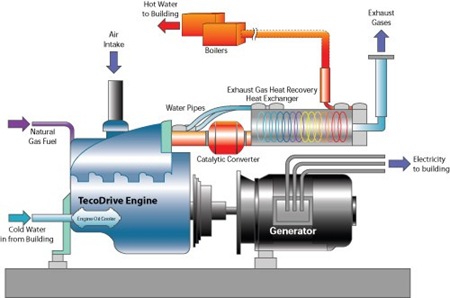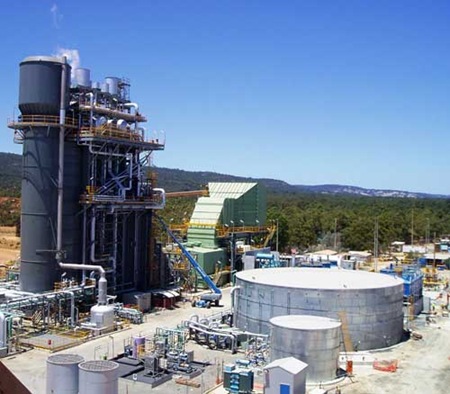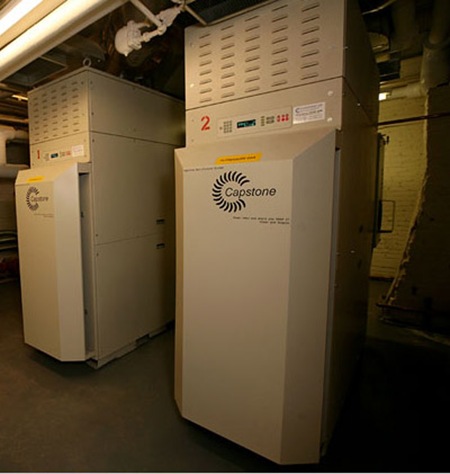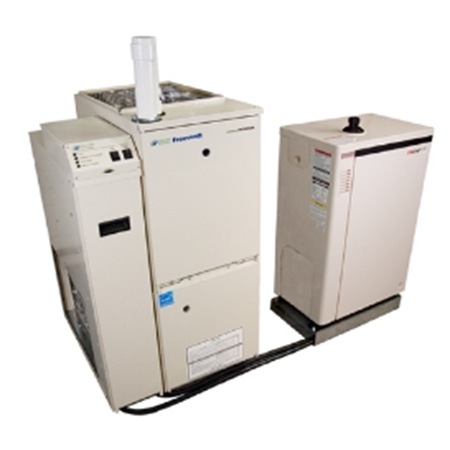1006 Morton Street
Baltimore, MD 21201
410.576.9131 | RW1haWw=
April 4 2008
Cogeneration - Have Your Electricity and Heat it Too.
Cogeneration has been in the news a bit more lately and it seemed like it was time for Greenline to offer a primer.
So what exactly is "congeneration?" In general terms, it's system which provides both heat and electricity from the same source of fuel. Such systems often take advantage of what would normally be wasted energy. In a typical power plant, for example, nearly half of the energy consumed is wasted as excess heat. A cogeneration plant would take the excess heat energy and convert it into something which can be used to heat buildings, create domestic hot water or fed into a manufacturing process.
Like most other generators, a cogeneration set-up requires a combustion engine of some sort which runs a generator to produce electricity. The difference is that the excess heat is sent through a heat exchanger before being allowed to escape up the smokestack. This second pass at using the combustion energy is what boosts efficiency from 50% or so on a typical generator to over 80% at a cogeneration plant.
Most systems are run by large public utilities. In New York for example, Con Edison has six power plants which use waste heat to send steam to nearly 4000 buildings. Inside the buildings, the steam power is used for heat, hot water and air conditioning.
Large, energy intensive industries often have their own cogeneration plant. At Alcoa's massive Pinjarra Alumina Refinery in Western Austraila, a new power plant sends electricity to consumers while pumping steam to be used in the aluminum processing facility.
In energy intensive industries such as aluminum processing, such plants are seen as worthwhile investments which can significantly reduce production costs. That they also help burnish a tarnished environmental image is a bonus.
In recent years, the technology has become more common-place and costs have come down enough to make smaller facilities viable. These systems often flip the primary function of the plant -- The plant's primary purpose is to generate heat energy and it secondarily provides power. Large office and multi-family residential buildings have been installing the systems to heat and cool spaces and then using the electricity generated to shave a portion of their electric load off of main utility grid.
The New York Times recently ran a great article on such a system installed at Astor Wines and Spirit's new store Manhattan. In thinking about the massive amounts of electricity that would be required to keep their wines at temperature, the owners wondered whether there was a better way to get the necessary energy. The store has installed two "microturbines" which produce about 120 kw of power. The waste heat runs their boiler to produce heat and hot water. Most importantly, however, the heat is run through an absorption chiller which converts steam to cold water. The cold water, in turn, runs the many refrigerators storing all the precious wine. These are the two main units:
While the units might look not a whole lot bigger than that gas furnace in your own basement, don't confuse them with being cheap. The overall system cost slightly shy of a half million dollars, with the turbines themselves costing Astor Wines about $250,000. Given the high energy consumption of the building, though, the system penciled out with an anticipated payback in just four years.
There are, however, options for the enterprising home owner. One example comes courtesy of Climate Energy which produces residentially scaled congeneration equipment.
Their systems pair a natural gas (or propane) turbine with a Honda generator to produce electricity. The excess heat is then used by a companion unit to either produce hot water for a radiator system or create heat for a forced air distribution system. A domestic hot water tank module can be added to the forced air system.
Climate Energy's products really only make sense in climates where the heat season is primary energy user. If you live in Florida, sit tight. We could, however, see other manufacturers eventually figuring out how to produce the smaller condensation chillers required to bring cogeneration air conditioning systems to the market.
Also keep in mind that you're still burning fossil fuels to heat and power your home. While increasing the efficiency of your system is laudable, simpler things such as having better insulation and windows or just buying a smaller home will help more in saving the planet and reducing your power bills.
Recent Posts
Reimagining Harborplace to Create Space for Both Private Development and Expanded Public Space » Lawyer's Mall Reconstruction Progress » Confronting the Conventions of Customary Practice » Reconceived Facades: New Roles for Old Buildings » Ivy Bookshop Opens for Business! »
Categories
Yellow Balloon Baltimore » Products + Technology » Industry + Practice » Other » Architecture »
Links
Organizations
- USGBC Baltimore Regional Chapter »
- AIA - American Institute of Architects »
- USGBC »
- The Walters Art Museum »
- Green-e »
- Center for Building Performance and Diagnostics (CMU) »
- Green Globes »
- Prefab Lab (UT) »
- Center for Sustainable Development (UT) »
- Architecture 2030 »
- Bioneers »
- Street Films »
- FreeCycle »
- Chesapeake Bay Foundation »
- Archinect »
- BD Online - The Architects Website »
- National Wildlife Foundation »
- Natural Resources Defense Council »
- Overbrook Foundation »
- Merck Family Foundation »
- Ecology Center »
- New Building Institute »
- Neighborhood Design Center »
- The Leonardo Academy »
- ZigerSnead Architects LLP »
- The Rocky Mountain Institute »
- Urban Habitats »
- ACORE - American Council on Renewable Energy »
- Parks and People Foundation of Baltimore »
- Open Society Institute of Baltimore »
- Natural Capital Institute »
- Passive House US »
- Svanen Miljomark »
- Green Restaurant Association »
- Rocky Mountain Institute »
- Green Exhibits »
- Green Roundtable »
- John Elkington - SustainAbility »
- SustainAbility »
- Building America »
- Endangered Species Program - Fish and Wildlife Service »
- Congress for the New Urbanism »
- Urban Land Institute »
- Cool Roof Rating Council »
- Montgomery County (MD) Public Schools Green Building Program »
- National Institute of Standards and Technology Software »
- Scientific Certification Systems »
- Community Greens »
- CBECS »
- CASE - Center for Architecture Science and Ecology »
Interesting Sites
- The Ecologist »
- Treehugger »
- Grist »
- WIRED »
- Planet Architecture »
- MiljoBloggAktuellt - Environmental News Blog (Swedish »
- Sustainable Design Update »
- Eikongraphia »
- World Architecture News »
- The Cool Hunter »
- Design Center »
- ZEDfactory »
- Architen Landrell Associates Ltd. »
- Environmental Graffiti »
- businessGreen »
- Best Green Blogs Directory »
- Groovy Green »
- EcoGeek »
- Urban Ecology »
- Locus Architecture »
- Urbanite »
- A Daily Dose of Architecture »
- Adaptive Reuse »
- Audacious Ideas »
- Big Green Me »
- NOTCOT »
- Sustainable Baltimore »
- Thoughts on Global Warming »
- Green Maven »
- WorldChanging »
- Go For Change »
- Building Green »
- Home Energy Magazine »
- Home Energy Blog »
- FEMA Map Service- Federal Emergency Management Association »
- Architectural Graphic Standards »
- E-Wire »
- Post Carbon Cities »
- Alt Dot Energy »
- Whole Building Design Guide »
- B'more Green »
- EJP: Environmental Justice Partnership »
- Baltidome »
- OneOffMag »




April 11th, 2008 at 3:00 PM
speakforthose
Thanks for this post. I'm associated with Recycled Energy Development (RED), which does cogeneration (also called "combined heat and power"). You give a good explanation of the process, but one thing I'd like to add is the national potential here. Energy recycling (which is basically what this is) would reduce our nation's greenhouse emissions by 20%. That's more than taking every single car off the road. It isn't happening more because of bad regulations that protect monopoly utilities, who would hate to lose business to energy recyclers. Thanks for this hat tip to cogen, though -- we need more of it!